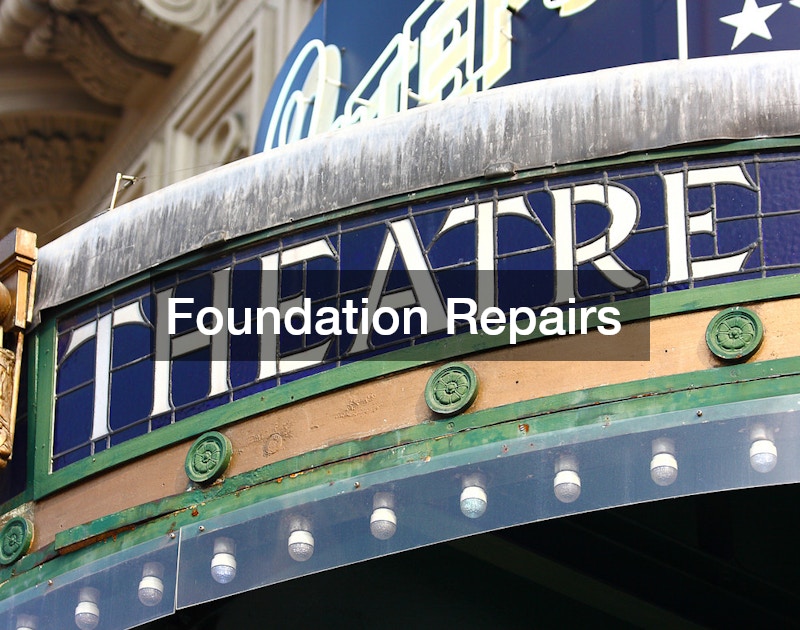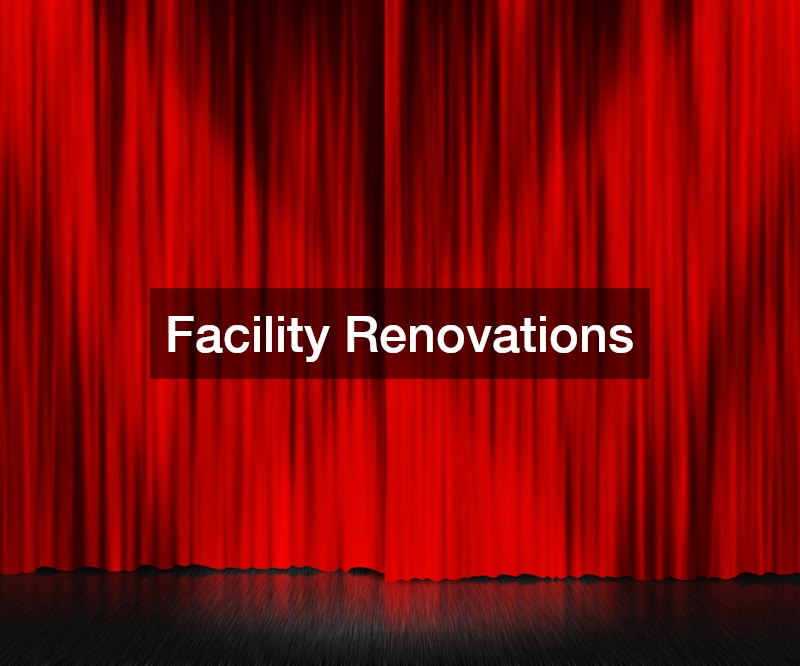Introduction
For any arts manager, maintaining and improving theater facilities is an essential part of ensuring a successful and comfortable environment for both performers and audiences. A well-maintained theater not only enhances the overall aesthetic appeal but also improves functionality, accessibility, and safety. Whether it’s updating the lobby decor, ensuring backstage areas are in perfect condition, or implementing essential repairs, each aspect of the facility needs attention. As the needs of modern theatergoers evolve, so too must the spaces that host them. For an arts manager, staying proactive in making facility improvements is key to enhancing audience experiences, improving staff working conditions, and protecting the longevity of the venue.
Lobby Decor

The lobby is the first area of the theater that patrons encounter, making its design a crucial aspect of creating a positive first impression. An inviting and aesthetically pleasing lobby can elevate the entire theater experience, setting the tone for what’s to come. The decor should balance functionality with style, offering guests comfortable seating, well-lit pathways, and visually striking elements that enhance the theater’s overall atmosphere. Modern theatergoers often expect elegant and well-designed spaces where they can relax before and after performances, so the lobby should serve as an extension of the artistic vision presented on stage.
One way to enhance the grandeur of the lobby is through the use of ceiling dome kits. These kits provide an elegant architectural feature that adds a touch of luxury and sophistication to the space. Installing a ceiling dome can help create a stunning focal point, offering guests something memorable even before the show begins. For an arts manager, such design features not only elevate the appearance of the venue but also add value to the theater as a whole, impressing visitors from the moment they walk in the door.
Accessibility Features
In today’s theater landscape, accessibility is a top priority, ensuring that every patron can enjoy the arts without facing physical barriers. For an arts manager, this means implementing features that make the theater accessible to individuals with disabilities. Whether it’s creating ramps, widening doorways, or improving seating arrangements, accessibility upgrades help create an inclusive space. These improvements not only meet legal standards but also demonstrate a commitment to welcoming all members of the community. Accessibility is a key consideration in ensuring that everyone, regardless of mobility, can experience the magic of live performances.
One specific improvement to consider is stair lift installations, particularly in older theaters where multi-level access may be limited. Stair lifts offer a practical solution for patrons who have difficulty navigating stairs, providing them with the freedom to move easily between different levels of the theater. As an arts manager, ensuring that stair lift installations are part of your facility improvements not only enhances the accessibility of the space but also reflects your dedication to accommodating the needs of every theatergoer. These installations help foster an environment where inclusivity is prioritized, ensuring everyone can enjoy the performances without limitations.
Foundation Repairs

Maintaining the structural integrity of a theater is one of the most important responsibilities an arts manager faces. Over time, buildings can experience wear and tear that leads to foundational issues, threatening both the safety and longevity of the facility. Cracks, uneven flooring, and other structural concerns can pose significant risks if left unaddressed. Proactively scheduling inspections and repairs is essential to ensure the building remains stable and safe for audiences, performers, and staff. Addressing foundation issues early on can prevent more costly and extensive repairs in the future, protecting the theater from significant damage.
Working with foundation repair companies is crucial for identifying and correcting any structural problems your theater may face. These experts can assess the foundation, recommend necessary repairs, and execute them in a timely manner. For an arts manager, partnering with a reputable foundation repair company helps ensure that the theater is structurally sound and capable of hosting events without safety concerns. A solid foundation not only protects the building but also provides peace of mind, allowing the focus to remain on creating unforgettable performances rather than worrying about potential damage.
Waterproofing
Water damage is a significant concern for any theater, as it can compromise both the structural integrity of the building and the quality of the performances. Leaks, flooding, or excess moisture can lead to mold growth, electrical issues, and damage to valuable equipment and props. For an arts manager, implementing effective waterproofing measures is a key aspect of protecting the theater from these potential hazards. By ensuring that the building is properly sealed against water intrusion, you can safeguard your theater’s longevity and ensure a safe environment for both performers and patrons.
Investing in high-quality waterproofing materials is an essential step in this process. Whether it’s sealing cracks in the walls, waterproofing the basement or lower levels, or protecting vulnerable areas like the roof, using durable materials ensures long-lasting protection. For an arts manager, working with experienced contractors to apply waterproofing materials can prevent costly damage down the line, while maintaining the theater’s structural integrity. By addressing waterproofing needs early on, you create a more resilient and secure facility, allowing the arts to thrive without the threat of water-related disruptions.
Costume and Wig Storage

Proper storage solutions are a must for any theater, especially when it comes to preserving costumes and wigs. These items are often delicate, expensive, and essential for bringing characters to life on stage. For an arts manager, creating an organized, climate-controlled storage space for costumes and wigs is crucial for ensuring that these pieces remain in pristine condition between performances. Temperature fluctuations, humidity, and improper storage can all damage fabrics and hairpieces, resulting in costly repairs or replacements. A well-maintained storage area ensures that costumes and wigs are easily accessible and protected, ready for use in every production.
Collaborating with hair salons can provide valuable insight into how to best store and maintain wigs, especially those made from real hair. Hair salons can offer tips on proper cleaning, styling, and storage methods to ensure that wigs retain their quality and longevity. For an arts manager, working with professionals in this field helps preserve the appearance of wigs, ensuring they look fresh and natural during every performance. Additionally, establishing a partnership with a local hair salon can also provide resources for restyling or refreshing wigs as needed, ensuring that your costume department remains a standout element of every production.
Waste Disposal
Theater operations generate a significant amount of waste, from set materials to costumes and general maintenance debris. For an arts manager, establishing a reliable and efficient waste disposal system is critical for maintaining a clean and organized facility. Proper waste management not only ensures a clutter-free environment but also promotes sustainability by encouraging recycling and responsible disposal practices. Whether it’s after a major production or during regular daily operations, keeping waste under control allows the theater to run smoothly and maintain a professional appearance.
Partnering with a local dumpster rental company can streamline the waste disposal process. Renting dumpsters tailored to your theater’s needs ensures that all waste is properly contained and disposed of in a timely manner. This is especially important during larger renovations or after significant productions when excess materials can accumulate. As an arts manager, working with a local dumpster rental company provides you with a convenient solution to managing waste, freeing up your time to focus on more critical aspects of running the theater. Proper waste disposal is essential for maintaining a clean and safe environment for everyone involved in theater operations.
Facility Renovations

As theaters age, periodic renovations become necessary to keep the facility functional, modern, and appealing to audiences. From updating the seating to redesigning the backstage area, renovations can enhance both the aesthetic and practical aspects of the space. For an arts manager, planning and executing facility renovations is a major undertaking that requires careful coordination, budgeting, and foresight. Renovations can breathe new life into a theater, making it more comfortable for patrons and performers alike while also boosting the venue’s overall appeal.
To begin the renovation process, partnering with demolition contractors can help clear out old or unusable sections of the theater. Whether it’s removing outdated fixtures, tearing down walls for an expansion, or preparing the space for new installations, demolition contractors play a key role in setting the stage for a successful renovation. For an arts manager, hiring the right demolition contractor ensures that renovations can begin on time and proceed smoothly, allowing you to focus on the next phase of improvements. Well-executed renovations can significantly elevate the theater’s profile and ensure that it remains a competitive and desirable venue for the arts.
Interior Appearance
The interior appearance of a theater plays a significant role in creating the right atmosphere for audiences and performers. The overall design, including the color schemes, materials, and architectural details, contributes to the theater’s identity and how patrons experience the space. A refined, elegant interior enhances the theater’s ambiance, while attention to detail in decor creates a sense of professionalism and care. For an arts manager, maintaining the interior’s appearance is an ongoing responsibility that helps preserve the theater’s reputation as a high-quality, inviting venue for the arts.
One way to improve the theater’s interior aesthetic is by installing crown moldings. Crown moldings add an element of sophistication to any space, offering a decorative touch that enhances the overall architectural design. By incorporating crown moldings into the theater’s decor, you can elevate the look and feel of the space, making it more luxurious and inviting for patrons. For an arts manager, investing in these finer details demonstrates a commitment to creating a polished and professional environment, which can significantly improve the audience’s experience and contribute to the theater’s long-term success.
Exterior Upgrades
While much of a theater’s charm lies within its walls, the exterior of the building is equally important in creating a welcoming environment for patrons. The exterior serves as the first point of contact for guests, setting their expectations for what lies inside. For an arts manager, upgrading and maintaining the exterior is crucial for preserving the theater’s public image and ensuring that it remains an attractive destination. Enhancements such as fresh paint, new signage, and attractive landscaping all contribute to creating a polished, professional appearance that draws audiences in.
A great way to improve the theater’s exterior appeal is by incorporating local plantation shutters. Plantation shutters not only add a touch of elegance to the theater’s facade but also offer practical benefits like improved ventilation and light control. They can enhance the building’s overall aesthetic while serving as a functional feature. For an arts manager, partnering with local providers to install plantation shutters allows you to enhance the building’s appearance in a way that aligns with its architectural style. These shutters can elevate the look of the theater, making it stand out as a well-maintained and professional venue.
HVAC Maintenance
The comfort of theater patrons and staff depends heavily on a well-functioning HVAC system. Proper heating, ventilation, and air conditioning are essential for maintaining a pleasant environment throughout the year, ensuring that guests can enjoy performances in comfort, regardless of the weather. For an arts manager, regular HVAC maintenance is key to avoiding breakdowns that could disrupt shows and ensuring that the theater remains a comfortable space for everyone involved. A well-maintained HVAC system also helps in energy efficiency, keeping utility costs down while providing consistent temperature control.
Collaborating with a local AC contractor for regular HVAC inspections and servicing ensures that your system is always operating at peak efficiency. Contractors can identify potential issues before they become costly problems, offering preventive maintenance and repairs when needed. For an arts manager, scheduling routine HVAC maintenance not only guarantees a comfortable atmosphere for your guests but also extends the life of the equipment, reducing the likelihood of expensive repairs or replacements. A reliable HVAC system is crucial for creating a consistently comfortable environment, helping to enhance the overall experience for audiences and performers alike.
Conclusion
In managing a theater, the arts manager plays a pivotal role in ensuring the facility remains functional, comfortable, and appealing to both performers and patrons. Every aspect of the theater, from the lobby decor to the HVAC system, requires attention to maintain a space that meets the needs of modern audiences. Whether it’s making structural repairs, updating accessibility features, or improving aesthetic elements, thoughtful facility improvements are essential for the continued success of the venue. Each enhancement contributes to the overall experience, helping to create a space where the arts can thrive.
By addressing necessary upgrades, such as foundation repairs, waterproofing, and exterior enhancements like plantation shutters, arts managers ensure the theater is not only a welcoming space but also a long-lasting and efficient one. Maintaining key systems like HVAC, waste disposal, and storage solutions further protects the theater’s functionality and safety. For an arts manager, investing in these improvements is a long-term commitment to both the arts and the community, ensuring the theater remains a vibrant, enjoyable place for future generations of performers and theatergoers alike.
